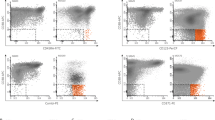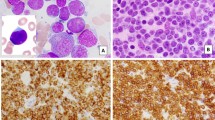Abstract
Aldehyde dehydrogenase (ALDH) activity is used to define normal hematopoietic stem cell (HSC), but its link to leukemic stem cells (LSC) in acute myeloid leukemia (AML) is currently unknown. We hypothesize that ALDH activity in AML might be correlated with the presence of LSC. Fifty-eight bone marrow (BM) samples were collected from AML (n=43), acute lymphoblastic leukemia (ALL) (n=8) and normal cases (n=7). In 14 AML cases, a high SSCloALDHbr cell population was identified (ALDH+AML) (median: 14.89%, range: 5.65–48.01%), with the majority of the SSCloALDHbr cells coexpressing CD34+. In another 29 cases, there was undetectable (n=23) or rare (⩽5%) (n=6) SSCloALDHbr population (ALDH−AML). Among other clinicopathologic variables, ALDH+AML was significantly associated with adverse cytogenetic abnormalities. CD34+ BM cells from ALDH+AML engrafted significantly better in NOD/SCID mice (ALDH+AML: injected bone 21.11±9.07%; uninjected bone 1.52±0.75% vs ALDH−AML: injected bone 1.77±1.66% (P=0.05); uninjected bone 0.23±0.23% (P=0.03)) with the engrafting cells showing molecular and cytogenetic aberrations identical to the original clones. Normal BM contained a small SSCloALDHbr population (median: 2.92%, range: 0.92–5.79%), but none of the ALL cases showed this fraction. In conclusion, SSCloALDHbr cells in ALDH+AML might denote primitive LSC and confer an inferior prognosis in patients.
This is a preview of subscription content, access via your institution
Access options
Subscribe to this journal
Receive 12 print issues and online access
$259.00 per year
only $21.58 per issue
Buy this article
- Purchase on Springer Link
- Instant access to full article PDF
Prices may be subject to local taxes which are calculated during checkout




Similar content being viewed by others
References
Bonnet D, Dick JE . Human acute myeloid leukemia is organized as a hierarchy that originates from a primitive hematopoietic cell. Nat Med 1997; 3: 730–737.
Hope KJ, Jin L, Dick JE . Acute myeloid leukemia originates from a hierarchy of leukemic stem cell classes that differ in self-renewal capacity. Nat Immunol 2004; 5: 738–743.
Lapidot T, Sirard C, Vormoor J, Murdoch B, Hoang T, Caceres-Cortes J et al. A cell initiating human acute myeloid leukaemia after transplantation into SCID mice. Nature 1994; 367: 645–648.
Blair A, Hogge DE, Ailles LE, Lansdorp PM, Sutherland HJ . Lack of expression of Thy-1 (CD90) on acute myeloid leukemia cells with long-term proliferative ability in vitro and in vivo. Blood 1997; 89: 3104–3112.
Blair A, Hogge DE, Sutherland HJ . Most acute myeloid leukemia progenitor cells with long-term proliferative ability in vitro and in vivo have the phenotype CD34(+)/CD71(−)/HLA-DR−. Blood 1998; 92: 4325–4335.
Sutherland HJ, Blair A, Zapf RW . Characterization of a hierarchy in human acute myeloid leukemia progenitor cells. Blood 1996; 87: 4754–4761.
Brendel C, Mohr B, Schimmelpfennig C, Muller J, Bornhauser M, Schmidt M et al. Detection of cytogenetic aberrations both in CD90 (Thy-1)-positive and (Thy-1)-negative stem cell (CD34) subfractions of patients with acute and chronic myeloid leukemias. Leukemia 1999; 13: 1770–1775.
Kastan MB, Schlaffer E, Russo JE, Colvin OM, Civin CI, Hilton J . Direct demonstration of elevated aldehyde dehydrogenase in human hematopoietic progenitor cells. Blood 1990; 75: 1947–1950.
Storms RW, Trujillo AP, Springer JB, Shah L, Colvin OM, Ludeman SM et al. Isolation of primitive human hematopoietic progenitors on the basis of aldehyde dehydrogenase activity. Proc Natl Acad Sci USA 1999; 96: 9118–9123.
Lioznov MV, Freiberger P, Kroger N, Zander AR, Fehse B . Aldehyde dehydrogenase activity as a marker for the quality of hematopoietic stem cell transplants. Bone Marrow Transplant 2005; 35: 909–914.
Storms RW, Green PD, Safford KM, Niedzwiecki D, Cogle CR, Colvin OM et al. Distinct hematopoietic progenitor compartments are delineated by the expression of aldehyde dehydrogenase and CD34. Blood 2005; 106: 95–102.
Hess DA, Wirthlin L, Craft TP, Herrbrich PE, Hohm SA, Lahey R et al. Selection based on CD133 and high aldehyde dehydrogenase activity isolates long-term reconstituting human hematopoietic stem cells. Blood 2006; 107: 2162–2169.
Fallon P, Gentry T, Balber AE, Boulware D, Janssen WE, Smilee R et al. Mobilized peripheral blood SSCloALDHbr cells have the phenotypic and functional properties of primitive haematopoietic cells and their number correlates with engraftment following autologous transplantation. Br J Haematol 2003; 122: 99–108.
Chute JP, Muramoto GG, Whitesides J, Colvin M, Safi R, Chao NJ et al. Inhibition of aldehyde dehydrogenase and retinoid signaling induces the expansion of human hematopoietic stem cells. Proc Natl Acad Sci USA 2006; 103: 11707–11712.
Mazurier F, Doedens M, Gan OI, Dick JE . Rapid myeloerythroid repopulation after intrafemoral transplantation of NOD-SCID mice reveals a new class of human stem cells. Nat Med 2003; 9: 959–963.
Kwong YL, Pang A . Low frequency of rearrangements of the homeobox gene HOXA9/t(7;11) in adult acute myeloid leukemia. Genes Chromosomes Cancer 1999; 25: 70–74.
Pearce DJ, Taussig D, Simpson C, Allen K, Rohatiner AZ, Lister TA et al. Characterization of cells with a high aldehyde dehydrogenase activity from cord blood and acute myeloid leukemia samples. Stem Cells 2005; 23: 752–760.
Yanagawa Y, Chen JC, Hsu LC, Yoshida A . The transcriptional regulation of human aldehyde dehydrogenase I gene. The structural and functional analysis of the promoter. J Biol Chem 1995; 270: 17521–17527.
Levis M, Murphy KM, Pham R, Kim KT, Stine A, Li L et al. Internal tandem duplications of the FLT3 gene are present in leukemia stem cells. Blood 2005; 106: 673–680.
Magni M, Shammah S, Schiro R, Mellado W, Dalla-Favera R, Gianni AM . Induction of cyclophosphamide-resistance by aldehyde-dehydrogenase gene transfer. Blood 1996; 87: 1097–1103.
Yang XW, Wang W, Fu JX, Cen JN, Guo F, Xia XM et al. Aldehyde-dehydrogenase gene-transduced hematopoietic cell line K562 overcomes the cytoxicity of cyclophosphamide in vitro. Zhongguo Shi Yan Xue Ye Xue Za Zhi 2002; 10: 205–208.
Moreb JS, Muhoczy D, Ostmark B, Zucali JR . RNAi-mediated knockdown of aldehyde dehydrogenase class-1A1 and class-3A1 is specific and reveals that each contributes equally to the resistance against 4-hydroperoxycyclophosphamide. Cancer Chemother Pharmacol 2007; 59: 127–136.
Purton LE, Bernstein ID, Collins SJ . All-trans retinoic acid enhances the long-term repopulating activity of cultured hematopoietic stem cells. Blood 2000; 95: 470–477.
Zhang J, Niu C, Ye L, Huang H, He X, Tong WG et al. Identification of the haematopoietic stem cell niche and control of the niche size. Nature 2003; 425: 836–841.
Ninomiya M, Abe A, Katsumi A, Xu J, Ito M, Arai F et al. Homing, proliferation and survival sites of human leukemia cells in vivo in immunodeficient mice. Leukemia 2007; 21: 136–142.
Acknowledgements
This work was supported by RGC grant (HKU 7548/05M) and a seed Funding Programme for basic research (HKU) to RL.
Author information
Authors and Affiliations
Corresponding author
Additional information
Supplementary Information accompanies the paper on the Leukemia website (http://www.nature.com/leu)
Supplementary information
Rights and permissions
About this article
Cite this article
Cheung, A., Wan, T., Leung, J. et al. Aldehyde dehydrogenase activity in leukemic blasts defines a subgroup of acute myeloid leukemia with adverse prognosis and superior NOD/SCID engrafting potential. Leukemia 21, 1423–1430 (2007). https://doi.org/10.1038/sj.leu.2404721
Received:
Revised:
Accepted:
Published:
Issue Date:
DOI: https://doi.org/10.1038/sj.leu.2404721
Keywords
This article is cited by
-
LncRNA XIST regulates breast cancer stem cells by activating proinflammatory IL-6/STAT3 signaling
Oncogene (2023)
-
Fabrication of a three-dimensional bone marrow niche-like acute myeloid Leukemia disease model by an automated and controlled process using a robotic multicellular bioprinting system
Biomaterials Research (2023)
-
Acute Myeloid Leukemia Stem Cells: Origin, Characteristics, and Clinical Implications
Stem Cell Reviews and Reports (2022)
-
Oncogenic transcriptional program driven by TAL1 in T-cell acute lymphoblastic leukemia
International Journal of Hematology (2019)
-
Effect of Cinnamic acid and FOLFOX in diminishing side population and downregulating cancer stem cell markers in colon cancer cell line HT-29
DARU Journal of Pharmaceutical Sciences (2018)



